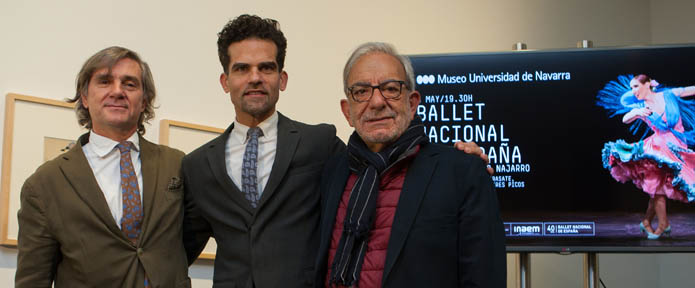Antonio Najarro, director of the Spanish National Ballet: "We want to update, not modernize, Spanish dance".
The Museum presented the show of the Ballet Nacional de España and inaugurated the exhibition 'Picasso. Le tricorne' with figurines and sets designed by the artist.

The Museo Universidad de Navarra presented this Friday a special project that brings together the performing and visual arts around the work Le Tricorne (The three-cornered hat). Thus, it has been presented the show that the National Ballet of Spain will take to the theater of the Museum this Saturday -from 19:30 hours-, and has been inaugurated the exhibition Picasso. Le tricorne. This exhibition brings the facet of the Malaga artist as a set designer and brings together 33 pieces, belonging to the Bancaja Foundation, which reproduce the original designs of the costumes and sets he made for the ballet.
Jaime García del Barrio, general director of the Museum, was in charge of opening this double presentation, in which he highlighted the importance that "interdisciplinarity and coexistence between the arts" have in the philosophy of the Museum itself.
Then, Jose Manuel Garrido, artistic director of Performing Arts of the center, and Antonio Najarro, director of the National Ballet of Spain, have pointed out the keys of the show that the company will perform on the stage of the theater. Afterwards, Rafael Llano, artistic director of the area of Public Programs, Research and Teaching, presented the exhibition, of which he is the curator, and which can be visited until July 1.
In his speech, Garrido highlighted Najarro's "splendid training", as well as the excellent work he has been doing at the head of the Ballet Nacional de España in the "recovery of Spain's choreographic heritage", a task that requires "great talent and generosity".
For his part, Najarro emphasized the magnificent opportunity to combine the representation of the National Ballet of Spain with the exhibition of Picasso. "His designs were very influential when it came to creating the choreography". Regarding his work as director of the company, he emphasized his commitment to "updating, not modernizing, Spanish dance, which is already modern without additives".
In this sense, he stressed the importance of carrying out projects that offer a new staging that can also attract young audiences, as well as showing Spanish dance on other stages such as a catwalk, the hall of a museum or in the world of sport: "Spanish dance is close and accessible, and we want to promote sensitivity, especially in the youngest. Without sensitivity, society does not evolve". He also explained that another of his goals is to position, with the importance it deserves, the bolero school, stylized dance and our folklore, with a very modern staging".
At the opening of the exhibition, Rafael Llano explained that Picasso was responsible for the costumes, sets and makeup, designs with which the Malaga artist "anticipates what is going to happen on stage. In the costumes there is a hierarchy and this can be seen in the designs of the miller, the miller, the corregidor, the corregidora and the secretary. There are five special costumes. There is a structuring of the colors according to the role that each character is going to adopt". He also pointed out the "important interrelation of the characters with the scenic space".